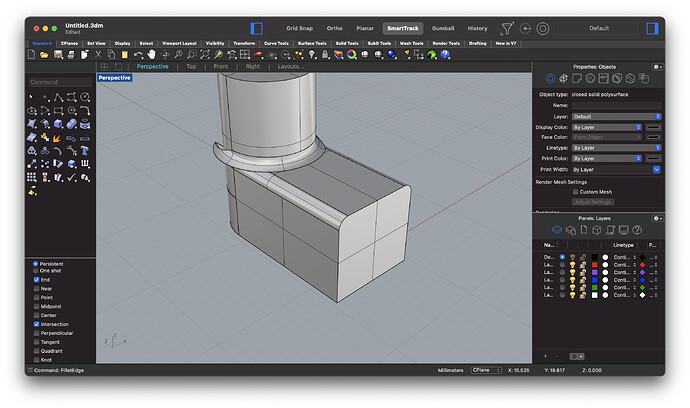Not really. I am a Rhino/Grasshopper user for 10 years, and I love it. I don’t consider it a direct competitor. My information is coming from using this particular feature quite extensively in the past. Rhino is admittedly not very good at creating fillets, and very often a lot of manual work is needed to make it work for more complex vertex configurations. Actually this is an area where Parasolid indeed excels, but my comment was not related to that at all. Even for G2 fillets a fully automated approach in the general case is an unsolved problem, and even Parasolid often messes it up completely.
Oh, you were talking about fillets in Rhino in general and not G3:s specifically - I misunderstood. Yes, Rhino has problems with more complex fillets and Parasolid is usually more robust.
You certainly can resolve all fillet problems in Rhino also, but it often requires a manual approach (and skill) and can be frustrating sometimes - but the advantage of a surface modeller is that any problem can be solved using surface modelling tools. However, if you encounter a fillet problem in a solid modeller (can happen sometimes) you’re usually stuck or end up with an ugly fillet (happened to me once - didn’t send in the modell, sorry).
So yes, I would like to have the robust and reliable fillets of Parasolid in Rhino also - as well as having surface modelling tools (for the reason I mentioned above, for instance) and G3 fillets/blends in Shapr  You can do it
You can do it  It can’t be impossible as there are modelling programs that make G3 blends all day long - and, for instance, the car industri relies on G3 continuity between surface patches. Nothing else seems to be good enough for their “class A surfacing.”
It can’t be impossible as there are modelling programs that make G3 blends all day long - and, for instance, the car industri relies on G3 continuity between surface patches. Nothing else seems to be good enough for their “class A surfacing.”
Philip
In many cases it’s insanely hard to fix them manually. My favorite examples are the cases where you have tangent edges. Parasolid does an amazing job even in this case. Fixing this in Rhino manually is often very labour intensive. And these are regular blends, not g2 blends. And if you want to change the radius… 
Yes, that’s a good example where Shapr (Parasolid) makes filleting so easy - I agree. Making the same G1-fillet in Rhino is however also possible even with the solid tools (without having to rely on surface tools), but you have to make the fillets in two steps. You need to first fillet the edges of the box and then the seams between the box (and fillets) and the cylinder. It’s important, though, that you place the seam of the cylinder away from intersection with the box - otherwise it won’t work - so it’s perhaps a bit cumbersome and something you need to know. It’s also possible to use different radii for the different fillets.
G2 is more involved and requires using surface tools in Rhino (at least in the current version).
Editing the fillets is really easy in Shapr - and not always so easy in Rhino. It’s possible to edit fillets in the same modelling session, but if you close and reopen the file direct editing is not possible any more. You could of course use Grasshopper and edit the model parametrically - or revert to an older version (on MacOS) and make new fillets, but that’s again additional steps.
And as long as I remember… Can I make a wish for an enhanced fillet tool: Variable surface fillets/blends with different radii along the fillet. Would that be possible?
(Apologies to the OP for taking this thread off topic…)
Oh, by the way - you need to update your Rhino to the latest service release - you have an older version 
Philip
We plan to deliver a lot of enhancements related to surface modeling in q2.



